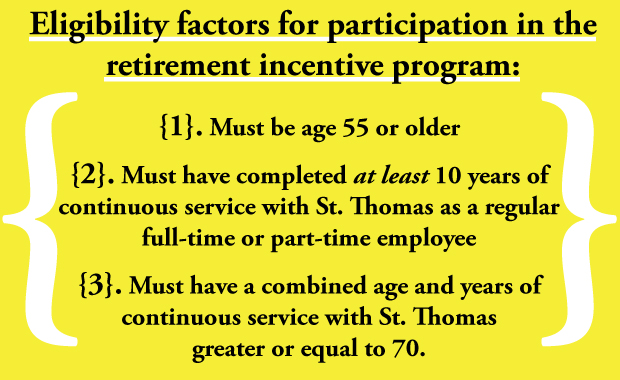
The demographics of St. Thomas’ professoriate will soon change as some tenured professors make a transition into retirement as part of a new incentive offered to eligible faculty and staff.
According to Deb Sagstetter, rewards and recognition manager, eligible faculty and staff who accept the buyout plan will receive a full-year salary compensation paid full or through bi-weekly installments.
Joseph Kreitzer, associate vice president of Academic Affairs, said the incentive will save the university money because it allows St. Thomas to hire new associate professors at a lower salary than experienced, tenured faculty.
“The arbitrage is if somebody retires who is a full tenured professor, 30-40 years here, and you replace them with somebody brand new into the professoriate in the same discipline, there could be maybe 20-25 percent differential,” Kreitzer said. “For one of those individuals to switch out like that, it could add up to a fair amount of money.”
Employees who qualify for the university’s full benefits package will receive a $7,250 benefits subsidy—the equivalent of covering one year of employee health insurance coverage under COBRA, a federal program for health care coverage.
In order to be eligible for compensation, employees seeking retirement must meet all of the criteria by Feb. 3, 2014. Employees must be 55 or older, have completed at least 10 years of continuous full-time or part-time service at St. Thomas and have a combined age and continuous service total of years greater than or equal to 70.
Adjunct faculty, temporary employees and staff under a collective bargaining agreement are not eligible for the voluntary retirement incentive.
The period for faculty and staff interested in voluntarily participating in the program begins Monday and will conclude Monday, Feb. 3. Participants must retire by May 31, 2014.
Retired professor John Cragan, who still teaches classes as an adjunct, said the program’s impact will be small.
“I think it’s a modest incentive for retirement. Lots of organizations have given bigger incentives. I think when you look at who took this, you’ll find that not a large number of professors did it,” Cragan said. “But it’s not wrong to do it; St. Thomas is not being miserly. It’s providing a little nudge for senior faculty to move comfortably into retirement and hopefully free up dollars.”
Kreitzer said the university could offer this retirement incentive every year if it saw fit, but it is not something it sees a need for.
“My guess is maybe 15 or 20 might take (the retirement incentive), but if 100 took it that’d be a real problem. If you lost a quarter of the faculty all at once that would be a huge challenge. So part of this not doing it every year or all the time is recognition of we just can’t afford to lose everybody in one swoop like that. We don’t want to lose all of that wisdom and experience,” Kreitzer said.
Kreitzer emphasized that the biggest benefit to hiring fresh, new professors is their up-to-date knowledge and energy.
“If you’re looking to work with a senior professor who is a very good teacher and that person decides to retire, in that case you are going to lose some people perhaps who might have been really fun, interesting,” Kreitzer said. “On the up side, you are going to get someone closer to your age, probably, or has different interests, abilities and skills, so there is a trade-off.”
Cragan wasn’t a tenured professor, but he said if the opportunity would have been available to him, he still wouldn’t have taken it.
“My decision on whether to retire or not retire was not driven by money,” Cragan said.
Cragan said the program is “not about good or bad professors, it’s about allocating resources in a tenured environment.”
“It gives you a chance to move people in a department that don’t have as much need as some other new, exciting departments. If you get some of the senior people to leave a couple of years early, that gives you a couple of years head start to reallocate the resources,” Cragan said. “Oftentimes it’s a good management practice to provide these packages so that you can more rapidly produce needed change in the university.”
Kreitzer said only 50 percent of a professor’s duty is teaching, and there is a lot more required of the job, so offering this incentive rewards experienced faculty with a year of the same salary and a break from all of the responsibilities.
“Most of the faculty I think who are going to opt to do this were thinking about retiring anyway. This is just the catalyst for them to decide to do it,” Kreitzer said. “If you are getting your salary continued for a year, that’s a nice perk.”
Zach Zumbusch can be reached at zumb8499@stthomas.edu.
